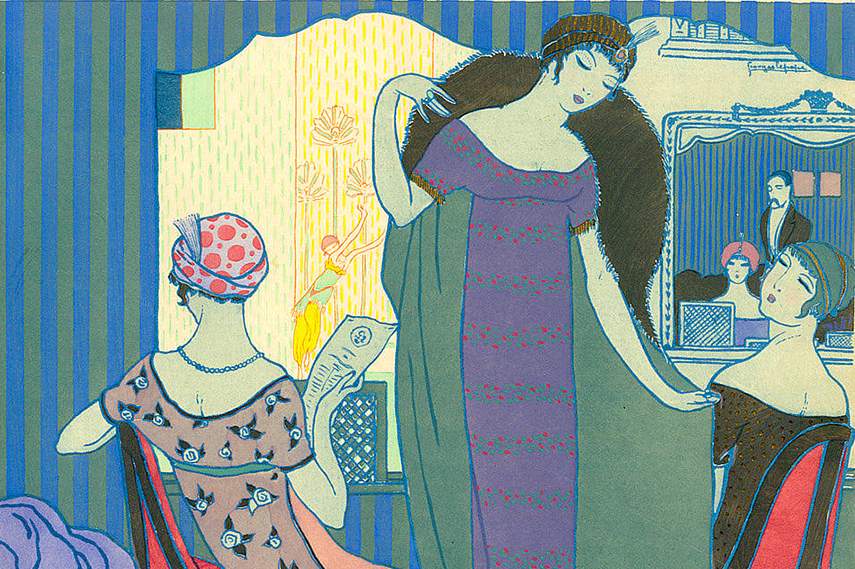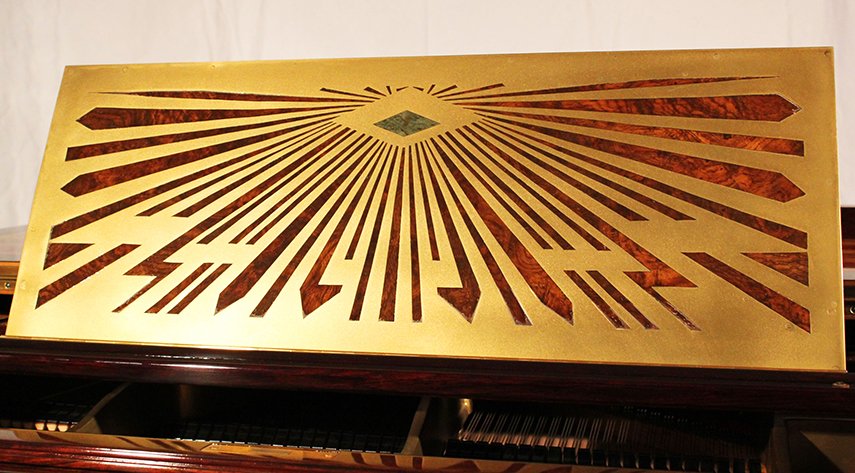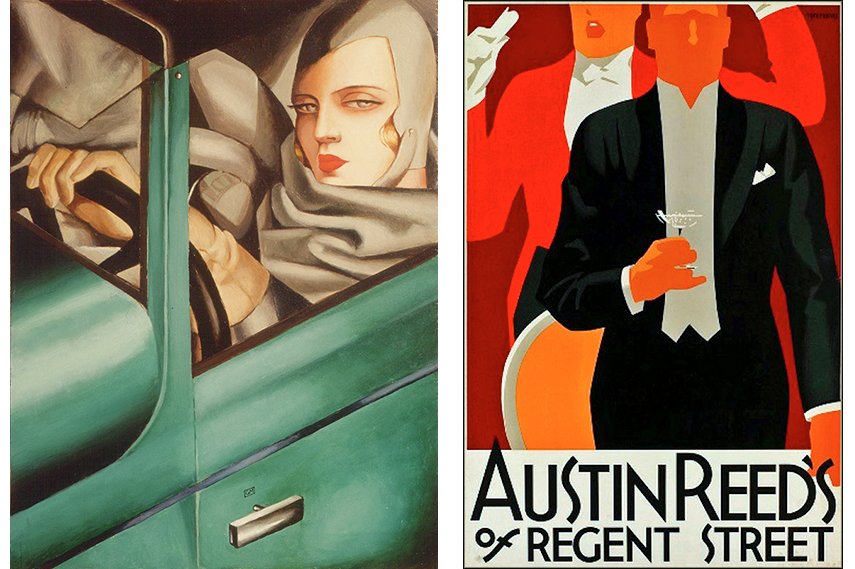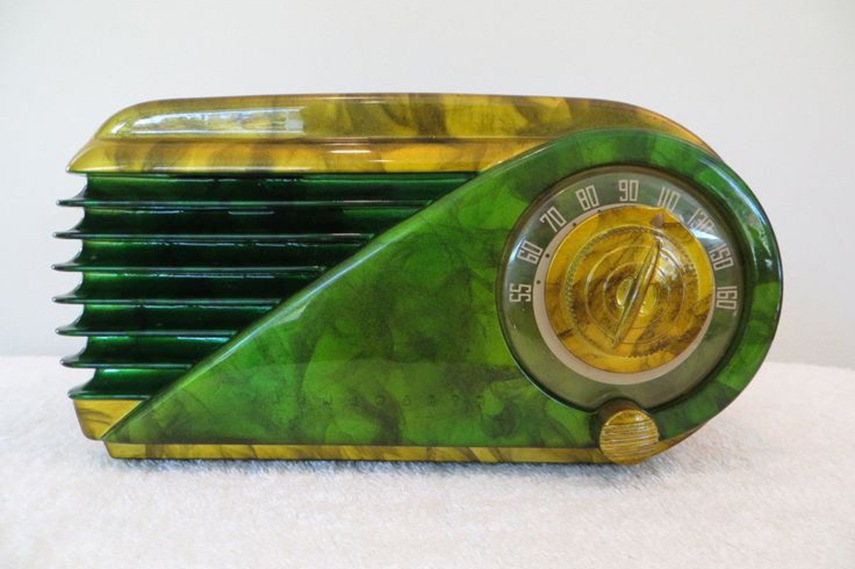Art Deco Is Considered to Be in Which Art Movement
What is Fine art Deco exactly and how tin can we distinguish between this particular style and like types of decorative art? Fine art Deco characteristics are hands distinguishable. We usually recognize Art Deco designs and objects intuitively, once we see them, but when it comes to the definition of this visual arts fashion, things tend to be a little more than complicated. First of all, in that location are different national variants of Art Deco and the Art Deco style itself is oft described as a pastiche of styles and an eclectic combination of influences, materials, and shapes. Therefore, it is sometimes hard to distinguish Art Deco from like schools like Art Nouveau, Art Moderne, Bauhaus school, or Arts and Crafts motion. All the same, there are sure characteristics that tin assistance us make up one's mind whether we are looking at Fine art Deco artworks and in the next couple of paragraphs, we will try to constitute those essential and typical features of Art Deco, exploring the characteristics of this decorative fashion in its various forms, from visual arts and Art Deco paintings to design and architecture.

Defining Fine art Deco
When we talk nigh Fine art Deco definition, we usually tell that information technology was certainly one of the virtually influential decorative styles in the first one-half of the twentieth century. It starting time appeared in French republic in the 1920's taking its proper name from 1925 Exposition Internationale des Arts Décoratifs et Industriels Modernes . Afterward its debut in Paris, Fine art Deco way was quickly accepted around the earth, drawing from the unlike sources and affecting various disciplines, from visual and decorative arts to fashion, compages, filmography and product design. Although information technology was the most popular motion in the period between two World Wars, it wasn't recognized as a motility in its own right until the sixties and some art historians even today fence whether Art Deco motility existed every bit such and if it should be identified as a singled-out style. Luxurious and excellent in their appearance, Art Deco paintings and designs marked the catamenia of newly plant optimism afterwards the war and bully depression. Although it drew its inspiration from the past art movements, one of the main features of Fine art Deco fashion was its orientation towards the future and celebration of modernistic ideas of progress.

Art Deco Era - Dialogue with the Past Art Movements
On numerous occasions, Art Deco was also called the "Cubism Tamed", referring to Fine art Deco elements which were borrowed from the Cubist movement. Fine art Deco characteristics primarily included the fascination with geometry, abstract and more fragmented forms. However, this is not the only motion Art Deco artists used as their main source of inspiration. This new style was founded on the avant-garde tradition, including Fauvism, Futurism, the visual language of Constructivism and Suprematism . Art Deco was historical in its relation to the important movements which preceded its birth, but it was also focused on contemporaneity and looking towards the hereafter. Except the abstract inspiration, Fine art Deco artists too searched for the exotic cultural elements they could incorporate into their artworks, and it is not surprising that in that location is a rich selection of cultural motifs, from ancient Egypt and Mesopotamia to Asia, Mesoamerica and Africa most of all. The selection of the motifs was also inspired by the local Art Deco variants, every bit this movement was the first global decorative fashion.

Art Deco in Relation to Like Design Schools: Characteristics of Style
The use of geometric forms and symmetrical compositions, every bit well as the combination betwixt fine arts and crafts, is what brought Art Deco closer to the aesthetic of the Bauhaus pattern school . However, these two movements were standing on the opposite sides of the modernist spectrum with Fine art Deco movement focused on luxury items and extravagant ornament opposing Bauhaus purist and unproblematic geometric forms and orientation towards utility and efficiency of modern living. Art Deco is also ofttimes compared to Art Nouveau as its forerunner. Just in spite of both movements being strongly influenced by the fine fine art tradition and lavishing ornaments, in that location are many differences between these ii influential styles from the commencement of the past century. The most obvious 1 is definitely the handling of shapes and lines. Art Deco, as a pattern move inspired past industrialization and technical progress, incorporated assuming geometrical patterns in symmetrical arrangements, vibrant, contrasting colors and it employed a diverseness of mod materials from aluminum to stainless glass and steel to plastic. On the other side, Art Nouveau primarily focused on the natural environment and designers and artists working in this style were trying to harmonize modernistic items with more natural-similar forms. Consequently, they used wooden materials oft and the shaping of metal and drinking glass was curvier, inspired by designs featuring organic forms like flowers, vines, leafs, insect wings or feathers.

Fine art Deco Mode in Visual Arts and Architecture
As a mode that combined arts and craftsmanship, Art Deco found its use mostly in the fields of compages, interior, fabric, furniture and fashion design. To a lesser extent, it can be constitute in visual arts, ordinarily painting, sculpture and graphic blueprint. Famous artists inspired by Art Deco aesthetics are painters Tamara de Lempicka and Jean Dupas, sculptors Paul Manship and Joseph Csaky and illustrators Erté and Paul Poiret among others. Fine art Deco mostly relied on collaborations of artists working in different mediums from architects and painters to sculptures and designers and in the Interwar periods it was the most commonly used architectural fashion, most notably in the United States. Art Deco was outset introduced to Americans in 1922, during the Chicago Tribune Headquarters design competition and it became one of the most popular architectural styles in the Usa during the showtime half of the century. Some of the almost recognizable buildings in the Usa like the Chrysler Edifice and Rockefeller Eye are representable of Art Deco style and patterns in architecture. Described equally modernistic, Art Deco style was often confused with Art Moderne.

Art Deco Today
Although it has lost its popularity afterwards the World War Ii, Fine art Deco was revitalized during the sixties and the ascension of the consumerist culture. Due to its global visual language and its nature that responds well to the requirements of the mass production, the heritage of this decorative mode is still present today, mostly in the field of manner, product and industrial design. Art Deco paintings and items are also becoming increasingly popular in the fine art marketplace and this newly found appreciation for the motion atomic number 82 to the establishment of many Art Deco foundations which continue to work on the restoration and preservation of architectural monuments built at the Fine art Deco golden ages.
Featured images: Tamara De Lempicka - Self Portrait in a Green Bugatti, 1929, detail; Tamara De Lempicka - Portrait of the Marquis d'Afflito, 1925. All images used for illustrative purposes
Source: https://www.widewalls.ch/magazine/what-is-art-deco-decorative-style
0 Response to "Art Deco Is Considered to Be in Which Art Movement"
Post a Comment